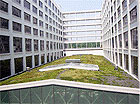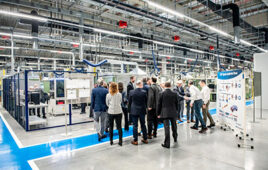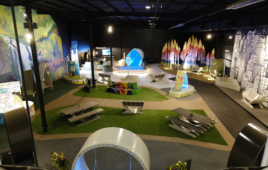Last year, the U.S. Congress passed legislation that included several new renewable energy provisions. This move is critically needed to encourage industry to step up the construction of more wind turbine generator and solar power facilities. Although wind, solar, clean coal, and nuclear power energy sources have been widely advertised and funded for some time, they are not the only means to help reduce the drain on natural resources. Another potentially valuable and environmentally friendly technology gaining widespread acceptance is green roofs. Green roofs are designed to hold soil and the vegetation that would otherwise have been destroyed when a new building is constructed. As American cities continue to spread and buildings and shopping centers swallow woods and fields, green roofs become even more important for preserving the ecosystem.

The Japan Organic Building, located in downtown Osaka, Japan, is an unusual example of a vertical garden incorporated into a commercial building. The nine-story concrete structure is encased in a steel outer skin with pockets that serve as enormous flower pots. More than 80 various plants and trees were specially selected for the particular environment. The plants are irrigated by a complex computer-controlled system. (Photo courtesy of A. Shaland.)
What’s more, green roofs give the environmental problem-solution issue a new slant: rather than produce energy, they help to conserve it. The largest contributing environmental factor of all types of green roofs is that they reduce storm-water run offs. These roofs hold rain water and dissipate it through evaporation and plant ingestion instead of dumping it into the sewer system. They also filter carbon dioxide and other air-borne pollutants, create habitat for birds and insects, provide space for growing flowers, vegetables, and fruits, and noticeably improve the buildings’ sound quality. Lastly, many green roofs are good insulators that can substantially reduce air-conditioning requirements. For example, conventional black tar roofs exhibit a heat-island effect that can raise its temperature to 180oF. Studies show that adding a green roof can lower the temperature by as much as 75oF.
Landscaping at ground level also contributes to the same goals as green roofs. Landscape designers select plants that shade large areas and control the sun light to help reduce heating, ventilating, and air-conditioning (HVAC) system needs. Often, prairie grasses are planted instead of traditional turf grasses because they need less water, fertilizer, and other maintenance.
Green roofs come in two major types: intensive and extensive. Intensive types primarily define the thickness of the soil level or substrate, the structural load, the variety of plants raised, and the amount of maintenance needed. They are often small parks that contain trees and shrubs that are maintained year-around and provide access to the public. Presently, intensive types are limited to flat-roofs.
Extensive roofs, on the other hand, can be placed on either flat or pitched roofs. By comparison, they have an extremely thin soil layer, require only once-a-year maintenance; and predominantly grow grass, moss, and herbs. These roofs are self-sustaining and are rarely open to the public.
Green roofs have other benefits: Roof repair and replacement costs decrease and the life of the roof can double because green roofs protect the tops of the buildings not only from heat, but also UV radiation, ice, and physical wear. In addition, green roofs are replacing conventional roofs that ordinarily support solar panels where they can overheat and fail due to the heat that rises from the roof’s surface. This latest technique, widely used in Germany, lowers the ambient temperature and significantly reduces solar panel failure rates.
Although it is a great improvement, adding a green roof to an existing building is not always possible nor does it make sense economically. Many buildings do not have sufficient existing structural strength to support the weight of a green roof or adequate waterproofing to prevent leaks and damage caused by the plant’s root system. The average cost of adding a green roof is $15 per square foot, and many building owners show little interest in making such changes.

Twelve stories high, the Chicago City Hall had a 22,000 square-foot, intensive-type rooftop garden installed in 2001 to demonstrate that green roofs can help reduce urban air temperature. Photo courtesy of Scholz-Barth, Katrin.
The best time to start planning for a green roof is at the outset of a project, long before the design gets under way. For example, when designing the Heritage Corporate Center in Cleveland, Ohio, architects from Ka Inc. calculated how much rainwater would be absorbed by the vegetated roof system and converted the intended storm water detention basin into valuable real estate. Also, smaller HVAC systems were needed because the green roofs provided substantially more insulation.

The Montgomery Park Business Center in Baltimore, Maryland has a 20,000 square-foot extensive-type green roof. Although the slope is modest, it is not intended for public access. It is primarily for energy-savings and environmental benefits. Photo courtesy of Scholz-Barth, Katrin.
Some of the most publicized green roofs are in Atlanta, Chicago, Dearborn, San Francisco, Washington D.C., Baltimore, and several other cities. The most highly visible installations are the Chicago City Hall, the Ford Motor Company assembly plant in Dearborn, Michigan, and the California Academy of Sciences in San Francisco, California. Yet another example, still in the planning phase, is the West Arriva hotel and residential complex in Calgary, Alberta, Canada. Gardens on lower level rooftops will be accessible by the residents and will improve the overall appearance of the complex. Although the typically severe northern climate limits the choice of plants that can be grown there, the architects selected several types of sedum to complement the color palette throughout the year.
For more information:
www.doe.gov
www.kainc.com
::Design World::
Filed Under: Green engineering • renewable energy • sustainability





Tell Us What You Think!